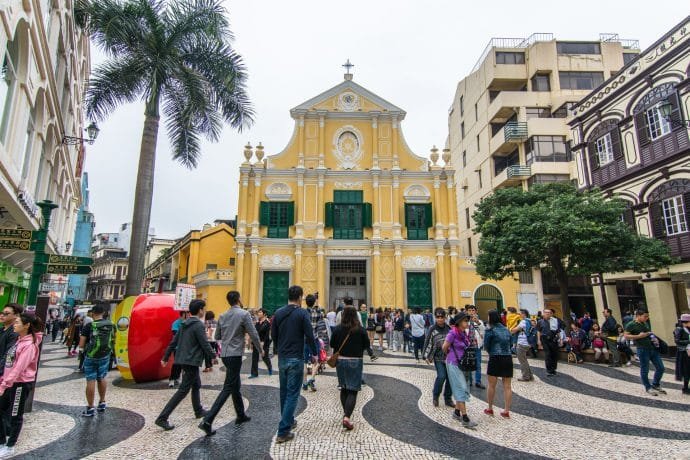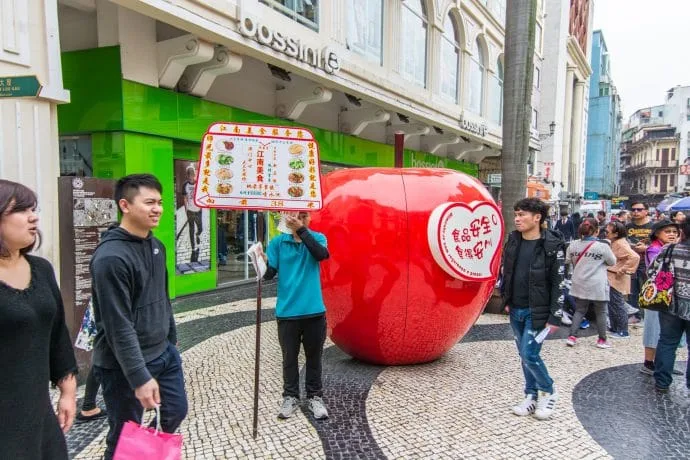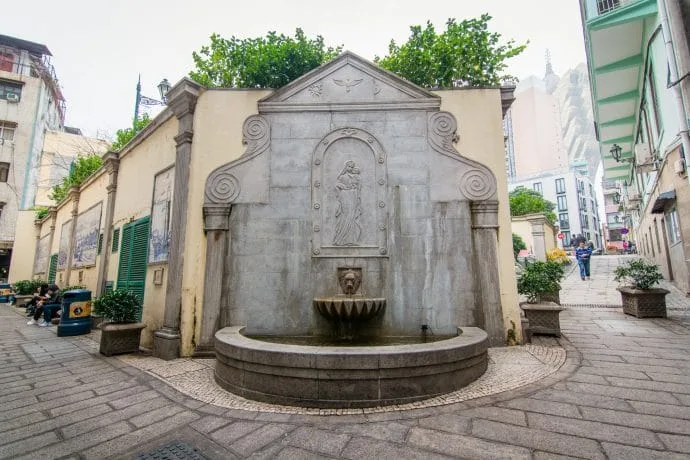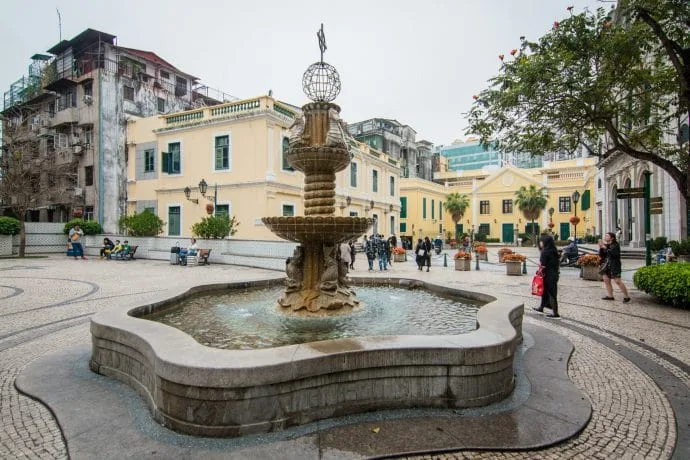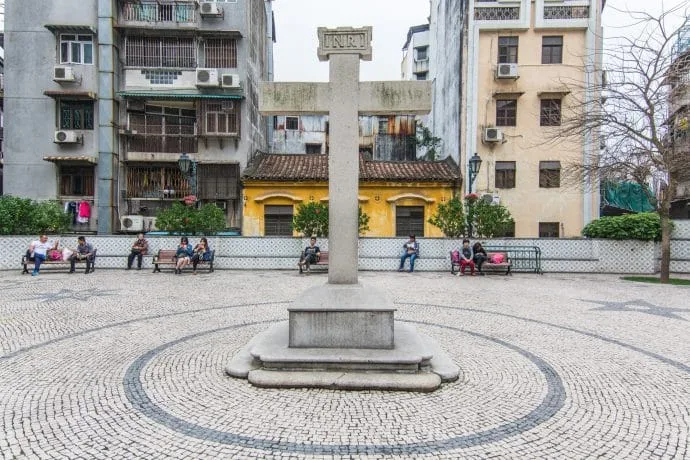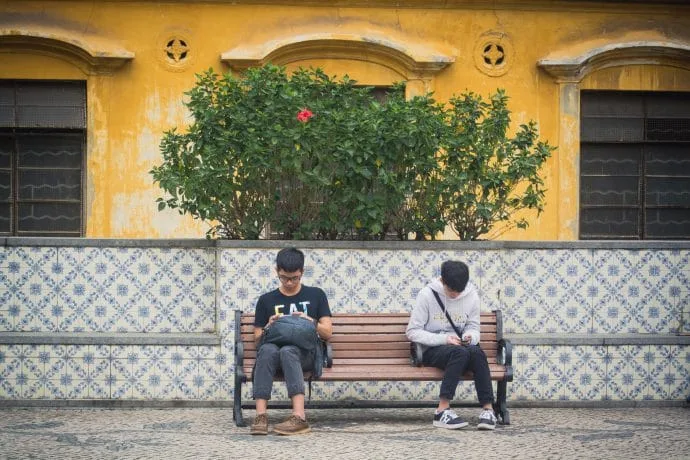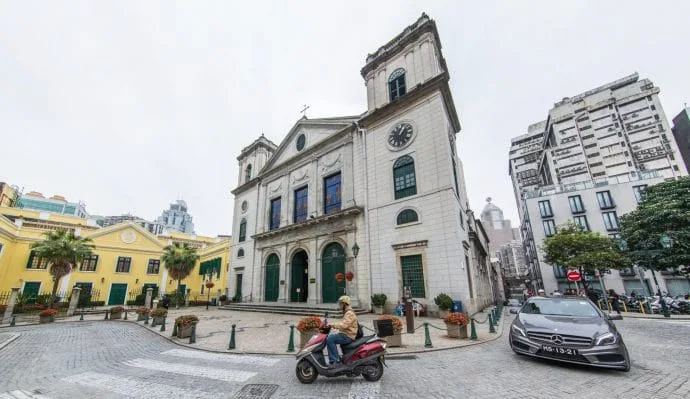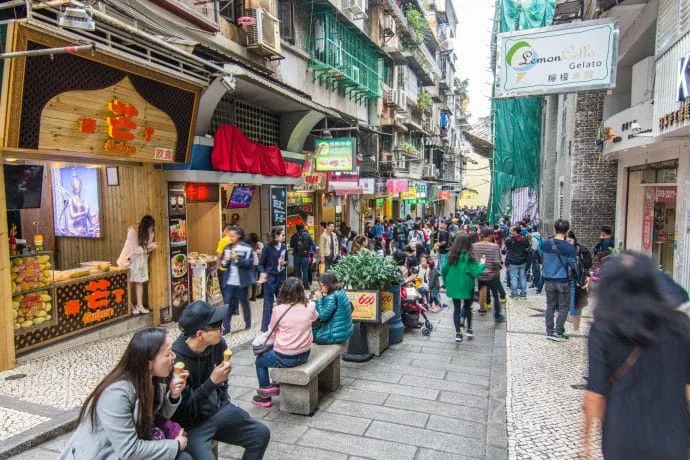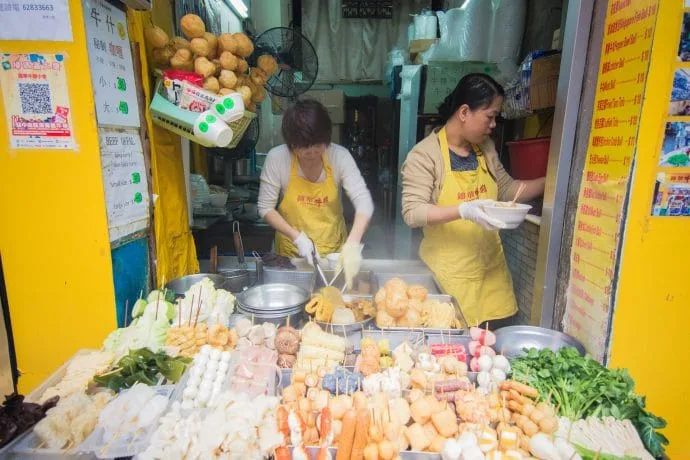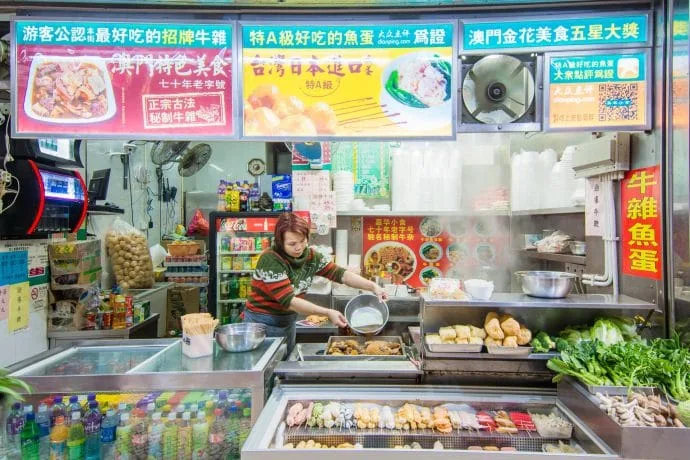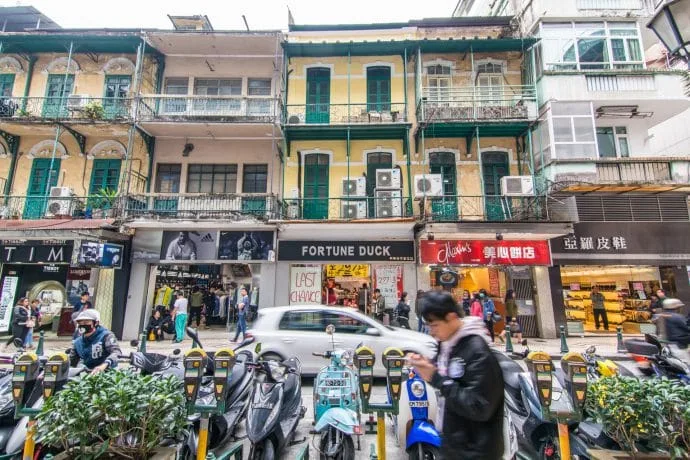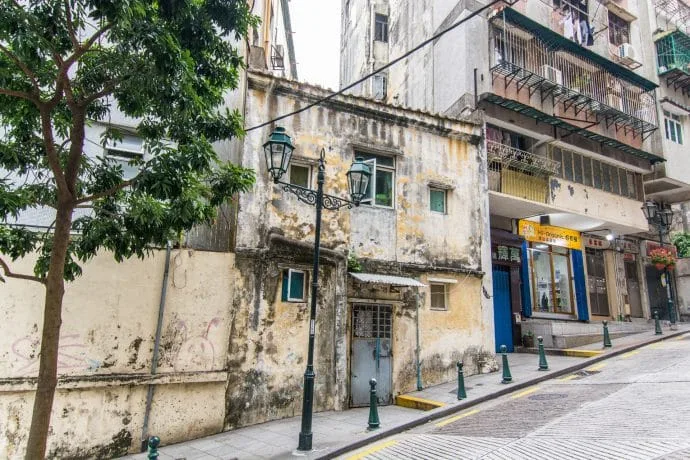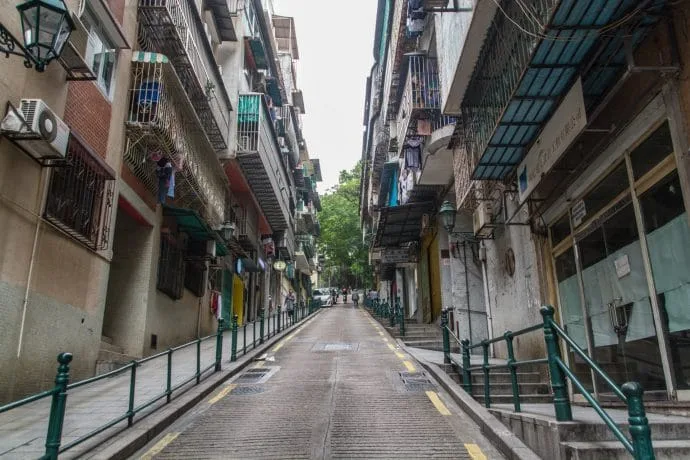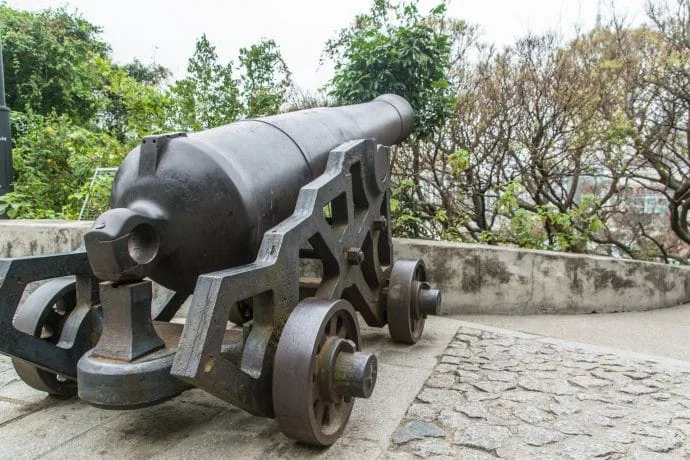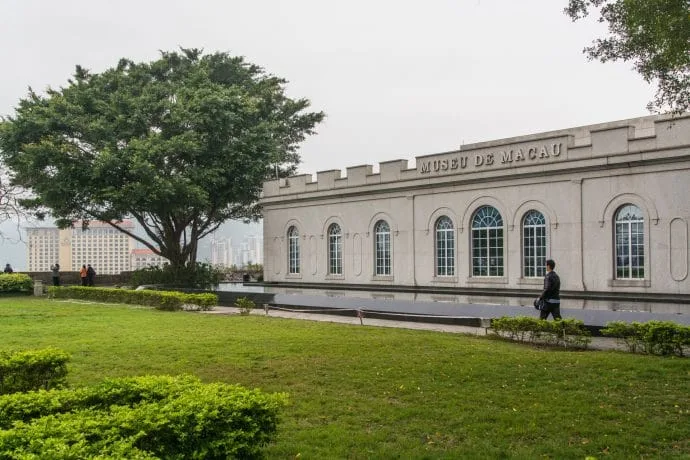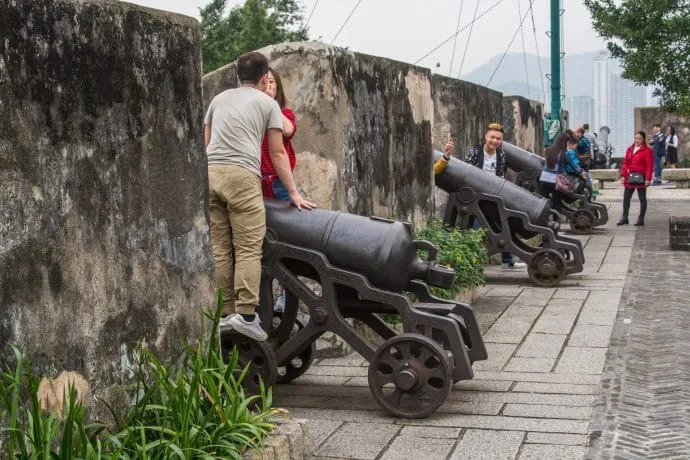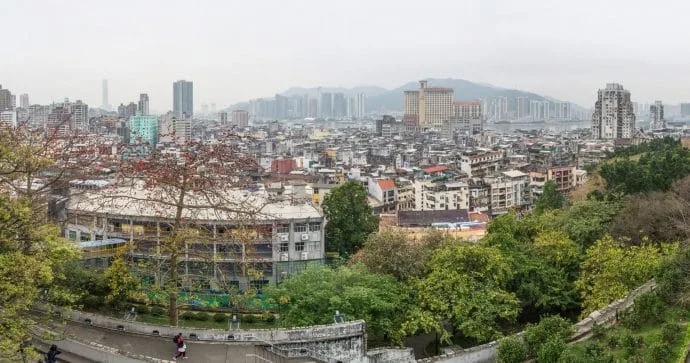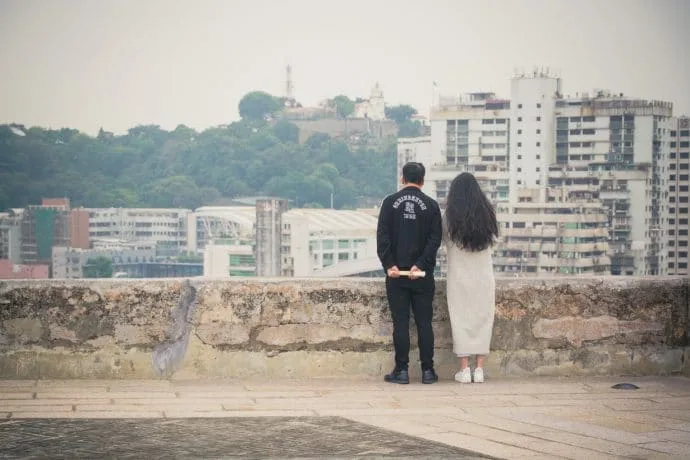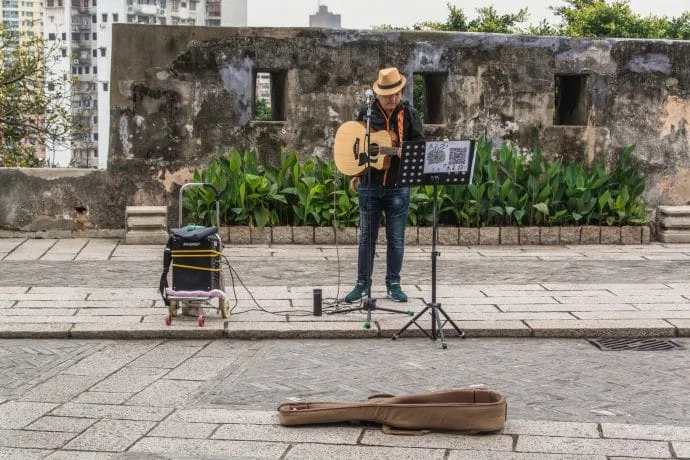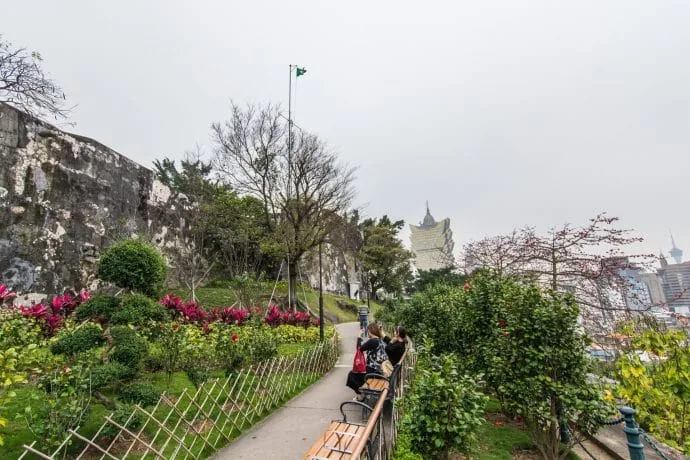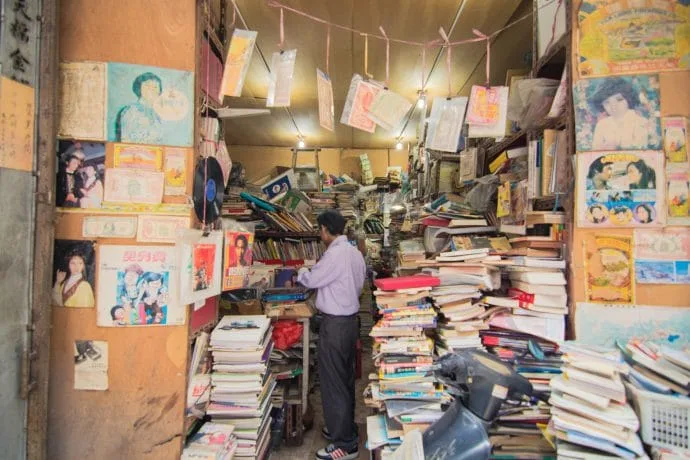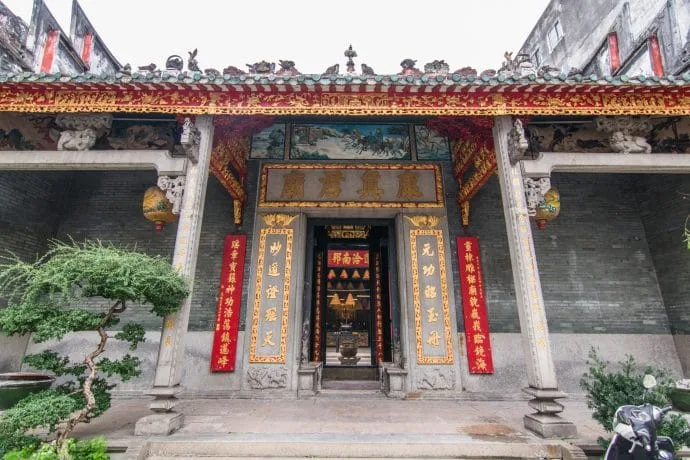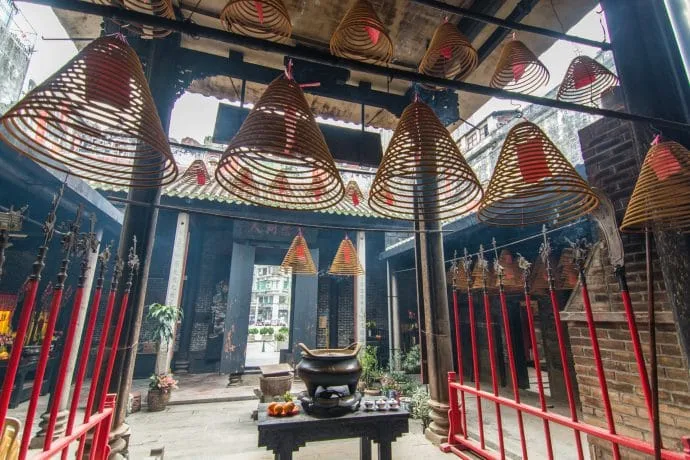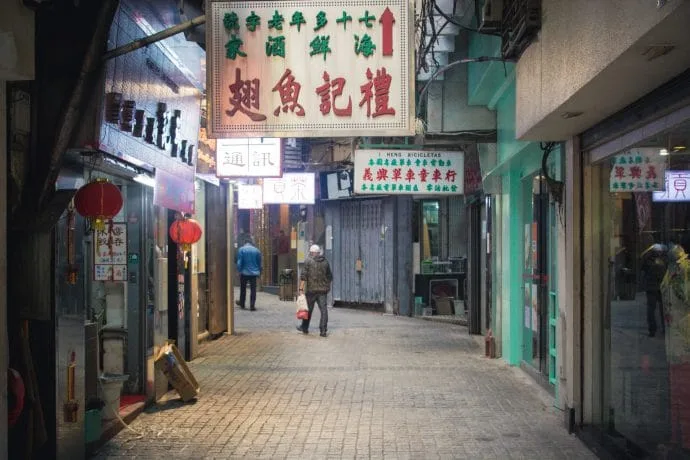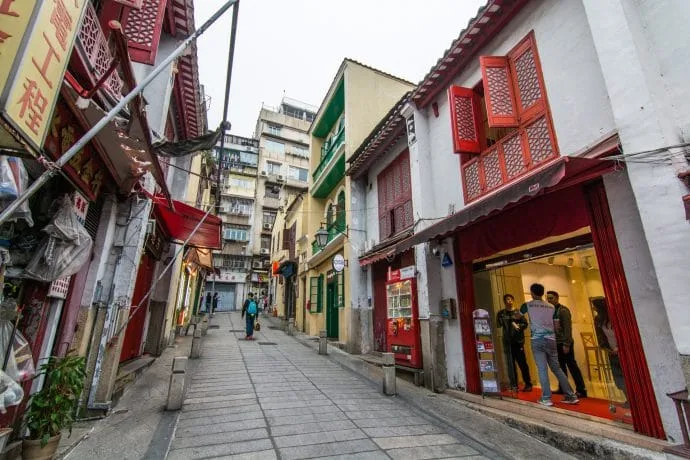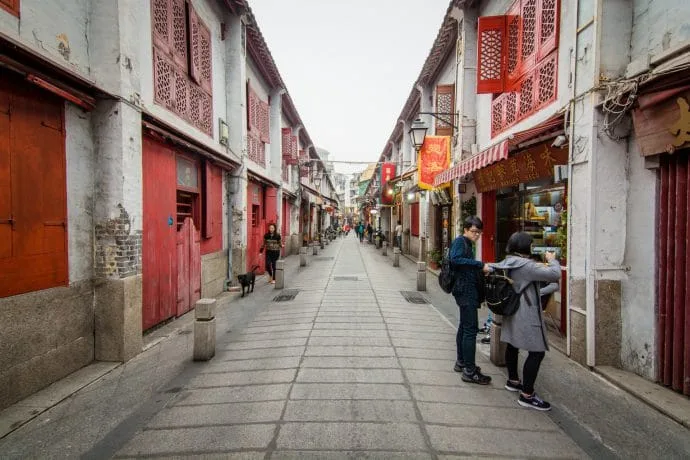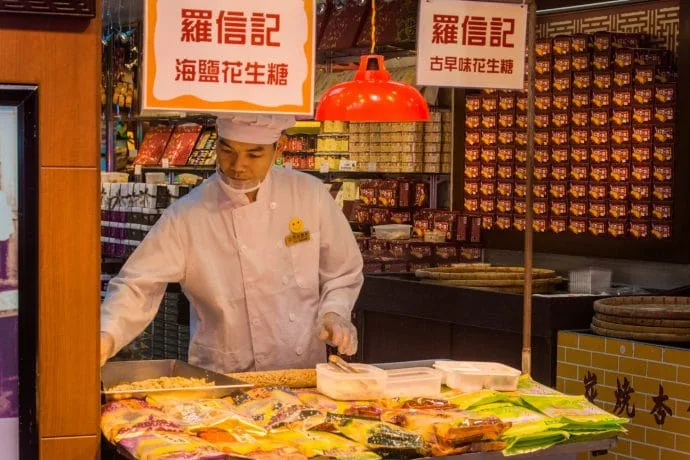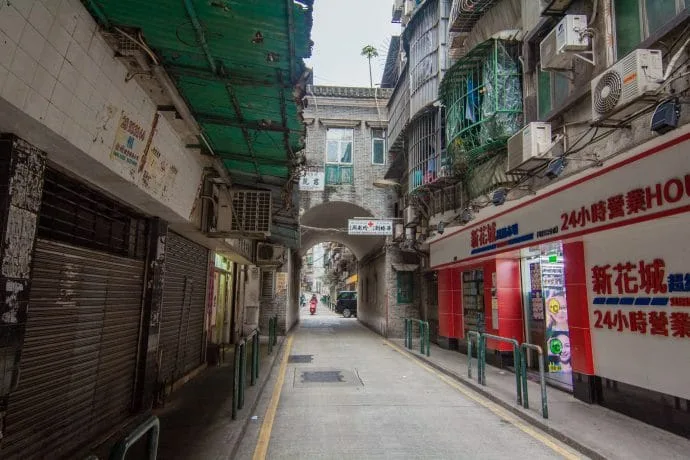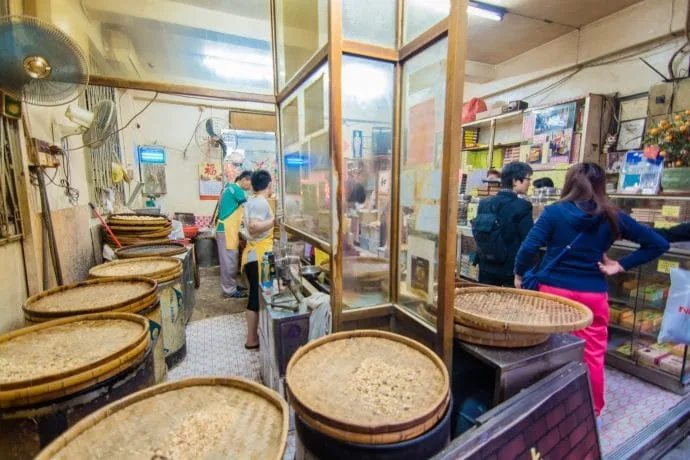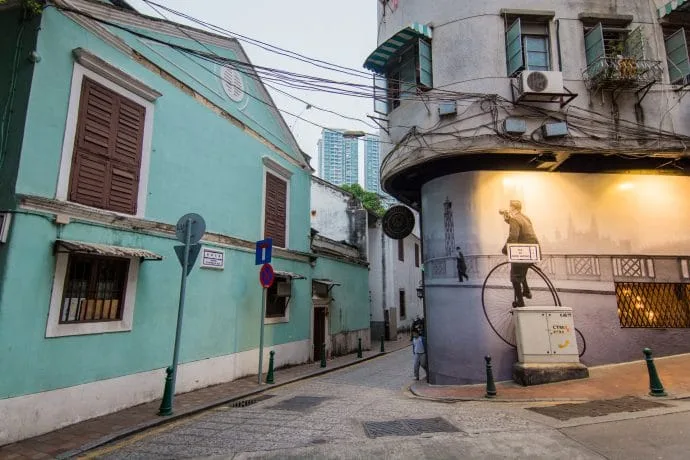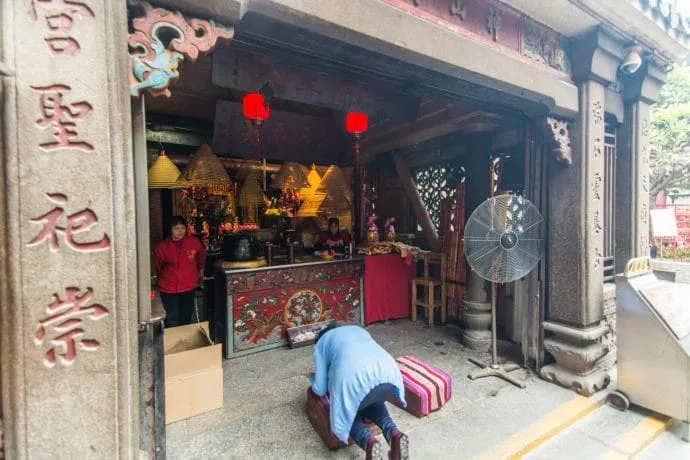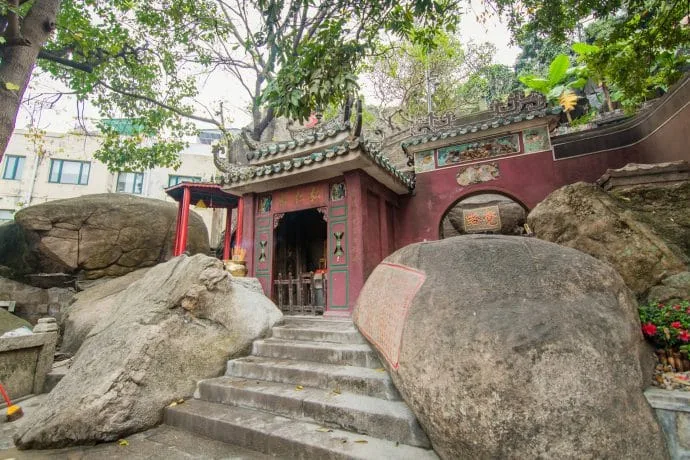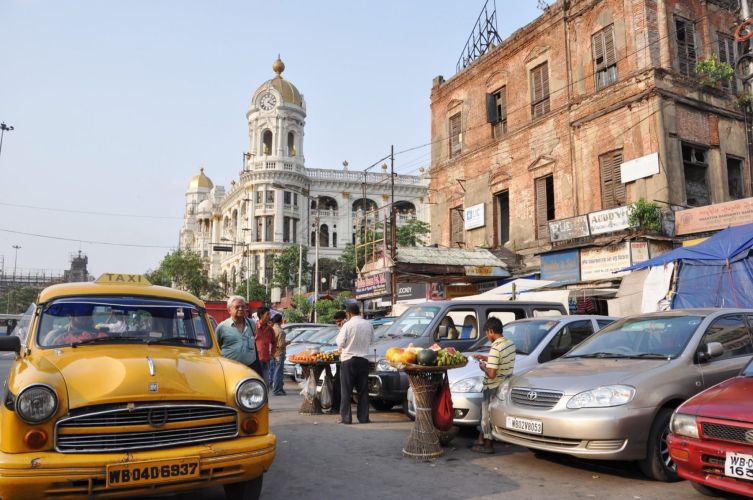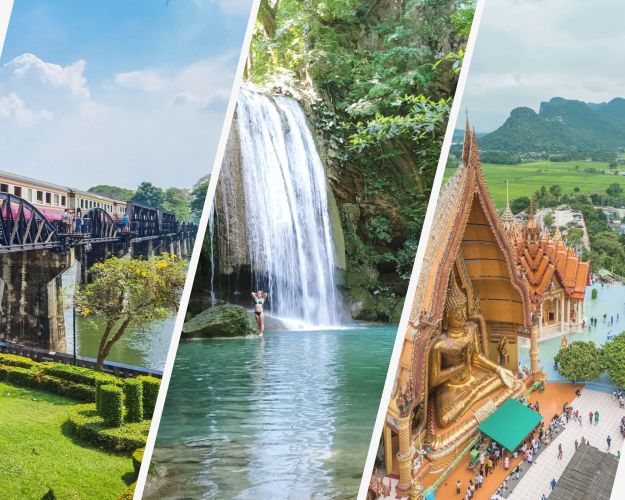While Hong Kong is usually visited as a stopover or as part of an overall trip to Asia, its "little sister" next door is more widely ignored.
In our case, taking advantage of a visit to Hong Kong this year, we also wanted to, while we were in the area, take a trip to Macao.
So, we stayed there for 2 days and 2 nights, which is more than average, because many people only stay for one day. However, our 2 days were quite full, because between the old town and the south island (including the towns of Taipa and Coloane, which I will write an article about later), there is still plenty to do.
Macao, a little piece of Portugal in Asia
Macao, another special autonomous region of the PRC (People's Republic of China, as a reminder), was colonized and administered by Portugal for more than 4 centuries. Having only returned to China in December 1999 (barely 2 years after Hong Kong, by coincidence of calendars), Macao is considered the last European trading post and colony in Asia.
The least we can say is that 400 years of colonization leaves its mark. Portuguese, the official language along with Cantonese, is omnipresent in Macau. All the signs have subtitles, there are newspapers in Portuguese, there are many Portuguese-style colonial buildings, typical Portuguese paving.
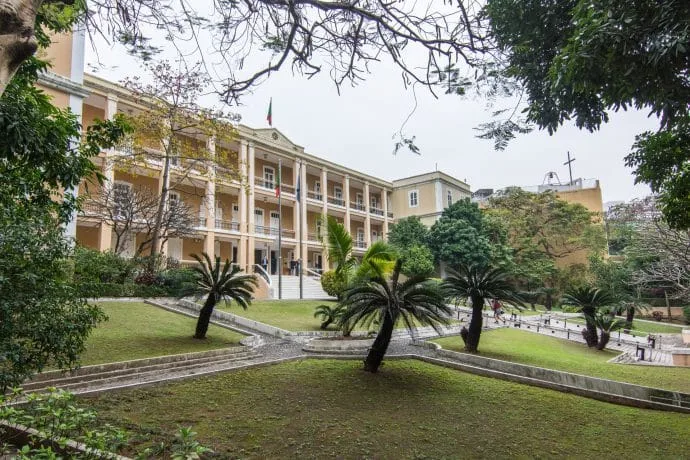
And yet, it remains Asia. You don't feel like you're in Europe at all, and it's precisely this mix of genres and cultures that gives Macau its charm. It's often forgotten, but the historic centre of Macau was added to the UNESCO World Heritage List in 2005.
For the record, Macau is ahead of Monaco and Singapore in terms of population density since more than 600 inhabitants live on the 000km30,4 that make up the islands forming Macau. Knowing in passing that its surface area is expanding since originally, the peninsula and the islands of Taipa+Coloane, which were separate, combined a surface area of barely 2km²!
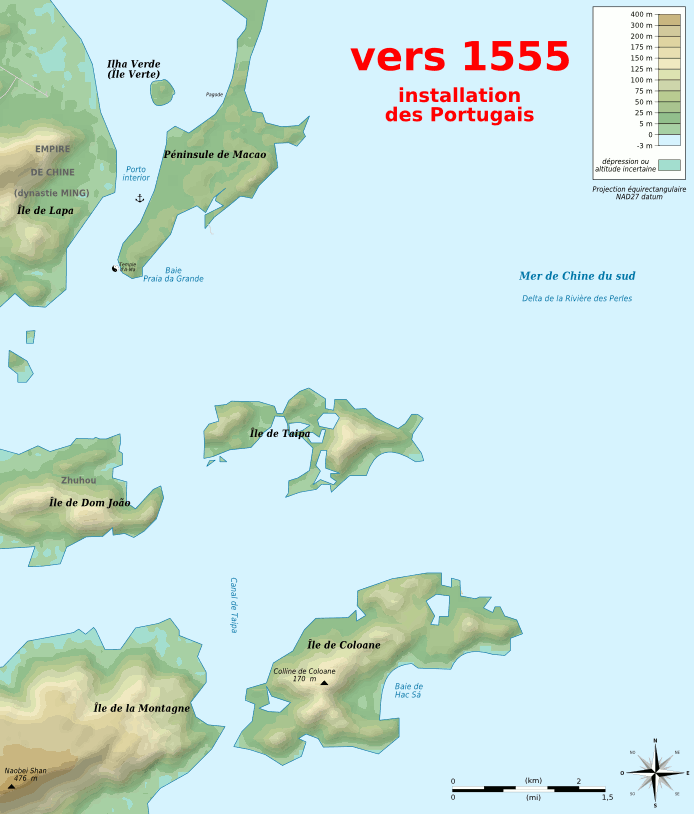
Good to know
Getting to Macau from Hong Kong
Since we were in Hong Kong, we reached Macau directly by ferry. We took the Turbo Jet company from the China Ferry Terminal. Fortunately, the latter was well signposted, because you have to enter a building that seems to contain offices and take an elevator to get to the ticket office level.
We walked to the terminal from Tsim Sha Tsui MTR station, 600m away.
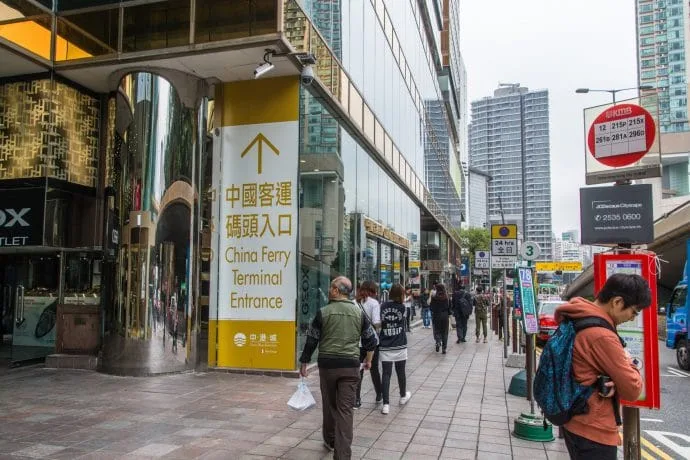
We bought our tickets from this company, because there was no queue and the tickets were even slightly cheaper at 150 MOP (Macau Pataca, the local currency, which is roughly equivalent to 15€ or 600 Baht), for a moment we wondered why… but no problem to report.
You can also buy your tickets in advance via the 12Go website: https://thailandeasie.12go.asia/
We went through immigration to leave Hong Kong and once we left, after a little over an hour, we landed in Macau.
We then took a taxi to travel the 3 kilometers that separated us from our hotel. If I remember correctly, it cost us 41 MOP, knowing that luggage in the trunk is an additional charge of 3 MOP each (so it was 35 MOP for the distance traveled).
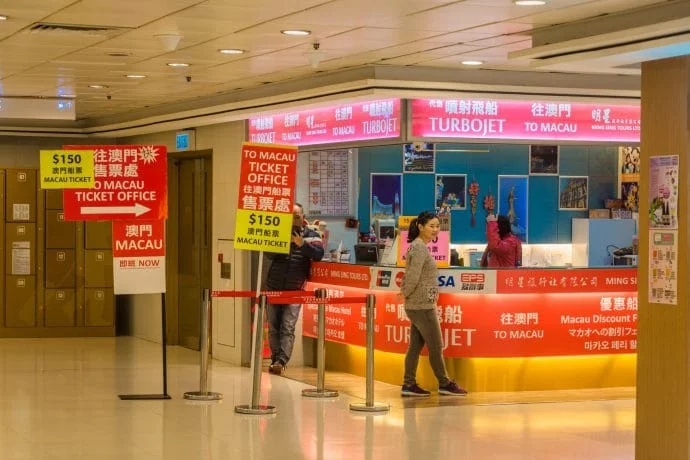
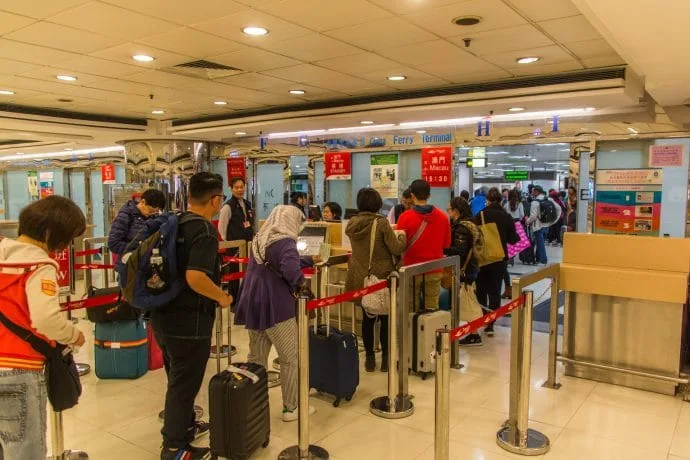
Where to stay in Macau: Little pleasure of the year!
For once, we decided to treat ourselves. In any case, the budget options are limited and while we were at it, we treated ourselves to 2 nights in a 5-star hotel. However, it wasn't that expensive, plus, by collecting points via Agoda, I got a 30% discount (it's not for nothing that I recommend the site).
It is therefore at Sofitel Macau at Ponte 16 Hotel, located opposite mainland China on the northern island of Macau, that we took up our quarters. As the name suggests, this is at pontoon 16, as it is located on the coast where the ferry docks are lined up (mainly for the transport of goods).
The hotel, like almost all of its category, has its own casino on the ground floor. The excellent surprise will come from the upgrade.
We had barely arrived when we were informed that we were going to have a room on floor 17, which, at the time, didn't particularly matter to us (apart from a better view perhaps...), but when we were told that this comes with advantages and that in this case, the floor in question is privatized and includes an all-you-can-eat buffet service at several times during the day, I can tell you that we were already enjoying our stay here!
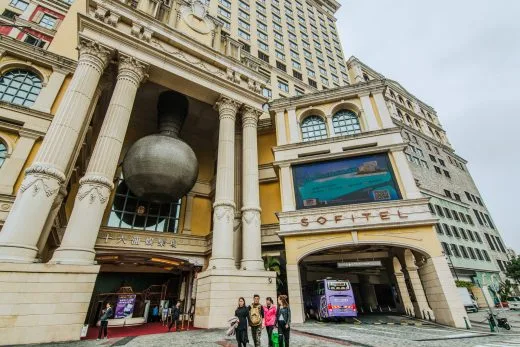
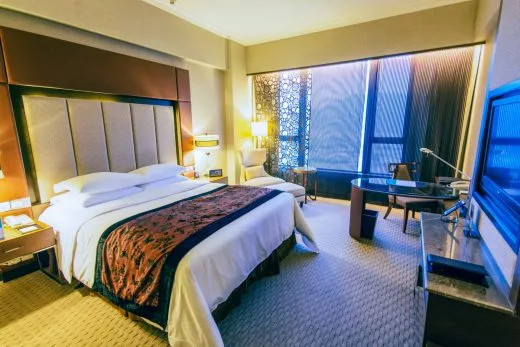
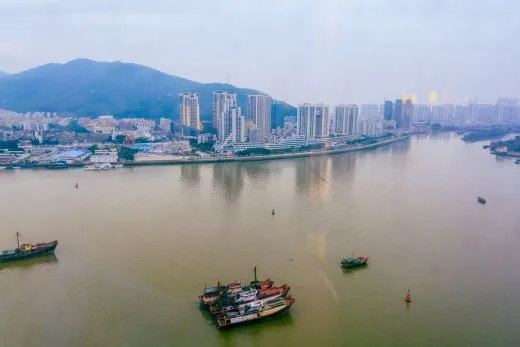
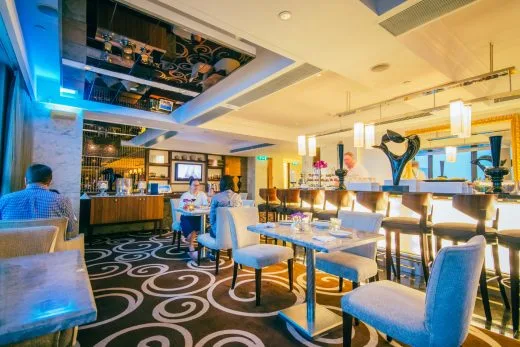
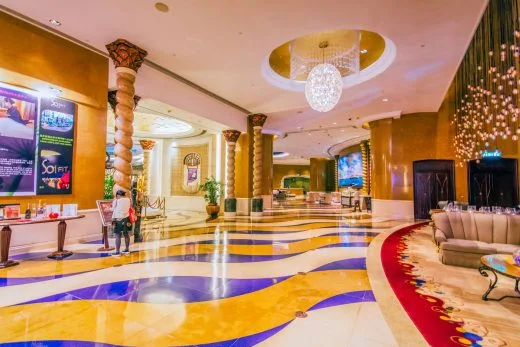
Jitima wonders if it is linked to my status as a "blogger", I assure him that it is not because I do not see at all why I should be entitled to this delicate attention, given that I have not manifested myself as such...
But I can tell you that we didn't hold back...

Macau Peninsula on a map
To help you find your way around the places I'm going to mention in the article, see my route transcribed on a map, divided into 3 parts, representing the 3 stages of our visit to the old town (early afternoon, late afternoon and finally the next morning).
I included the buildings visited or mentioned in the article as well as one of the only restaurants tested (after our visit to the casinos, see the article below)
Largo de Senado, the heart of old Macau
After a good night's rest, and taking our time, we went everywhere a little before noon, not without having enjoyed the morning buffet. Then it was towards the Senate Square, or "Largo de Senado" locally, that we went. Around this square, there are a good twenty buildings of historical value. Starting with the large square itself and its typical Portuguese paving on the ground.
You can clearly feel that this is the heart of the old town, because there are a lot of people. Around it, you can see the Leal Senado (for Loyal Senate, former seat of the Macau government), the Holy House of Mercy, a fountain, built more recently in the middle.
The most surprising thing is to know that the square was once open to traffic and served as a parking lot... It was only with the gradual arrival of tourists that the square was paved in 1993 and the area became pedestrianized.

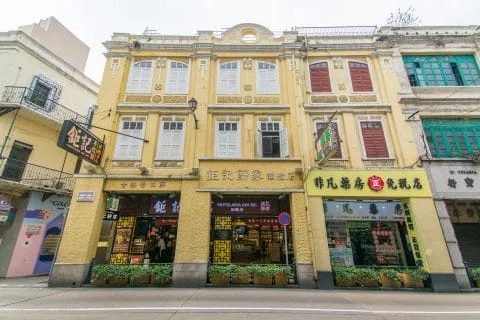
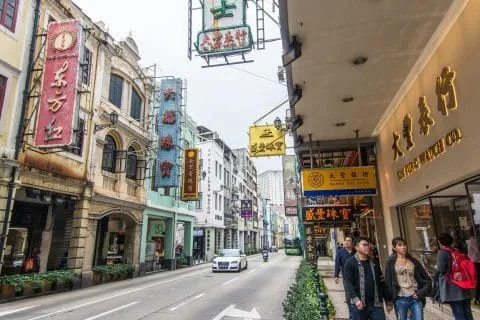
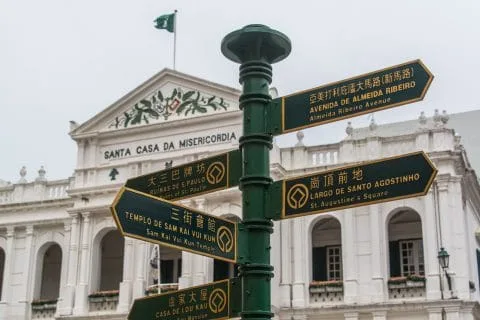
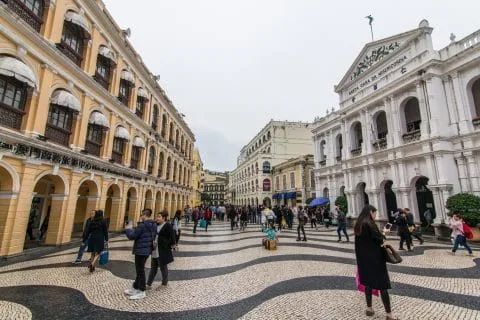

As we walked up the square towards the fort overlooking the old town, we took a look inside the Church of St. Dominic (Sao Domingo), with its Baroque altar. This church was once made of wood when it was founded in 1587. They display a collection of over 300 religious objects from various periods on the upper floors.
If it weren't for the mostly Asian crowd, it would almost feel like we were somewhere in an old European city. I am still amused by these men and women holding up signs promoting a shop selling pastries or other appetizers.
We entered the small street of Sao Domingo and came out on a small square, the place of Sé and its "small" cathedral of Sé, also simply called cathedral square. I must have stayed here for no less than 20 minutes. It gave me time to observe the surroundings, to soak up this atmosphere of a small square which is surrounded by several colonial-style buildings.
While many of these colonial buildings are European in style and date from between the 16th and 18th centuries, Chinese architecture is also well represented in Macau. This mix of genres is very nice to see and already makes me appreciate Macau for what it is above all, an ancient city, at the crossroads between Europe and Asia.
Taking another alley around the corner, we passed the Lou Kau Mansion. A house of a wealthy Chinese merchant, built in 1889. This one is similar to some houses visited in Georgetown, on the island of Penang in Malaysia but here it has an architectural mix between East and West.
The interior respects the principle of Feng Shui and the mansion has some particularities, in addition to beautiful sculptures on the door tops, Manchurian style windows but with Portuguese style shutters.
Meanwhile, outside there is a buzz of activity with people snacking and trying the local specialties. Which we put off until later, as we were still quite full from our welcome buffet at the hotel.
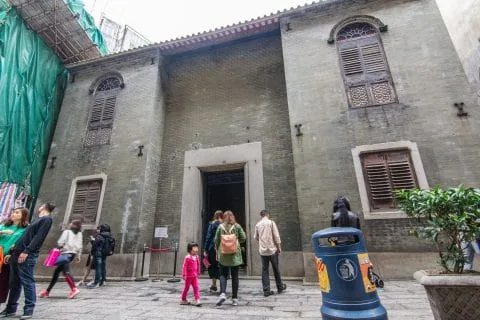
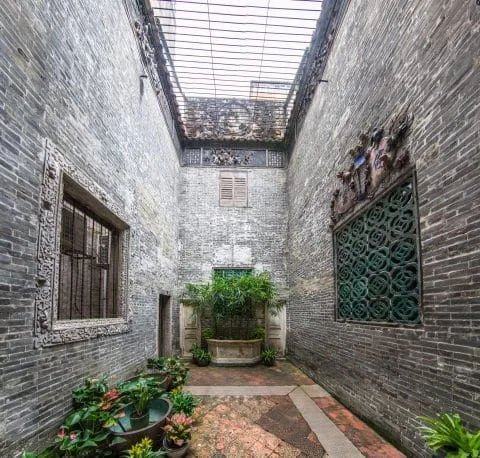
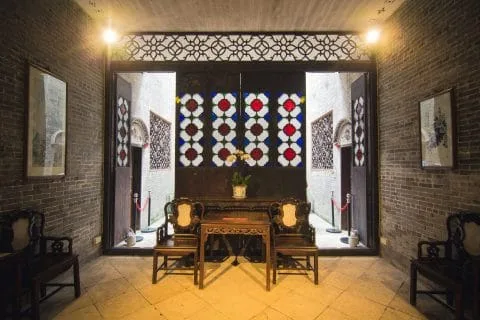

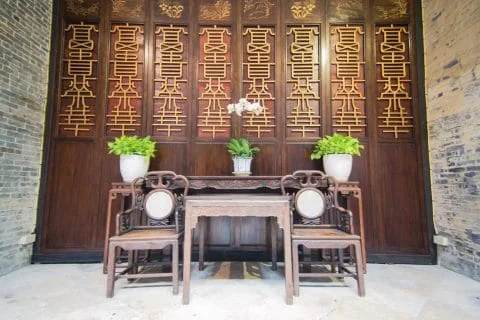
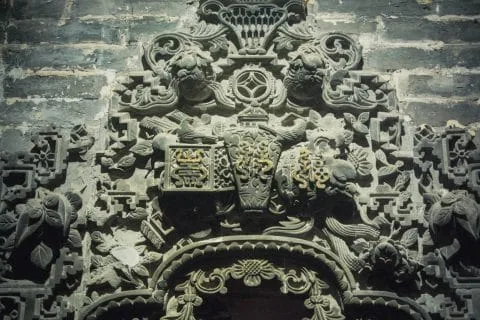
Fort Monte and the ruins of St Paul
So we gradually moved away from the crowd around the square and climbed up to the fort via the Calcada de Monte, which passes right next to the Portuguese consulate. The slope is steep to go and see the view.
The name simply means the hill fort and its official name is obscured since it is the Fortaleza de Nossa Senhora do Monte de São Paulo, in English: the Fortress of Our Lady of Mount Saint Paul. We agree that Fort Monte is shorter.
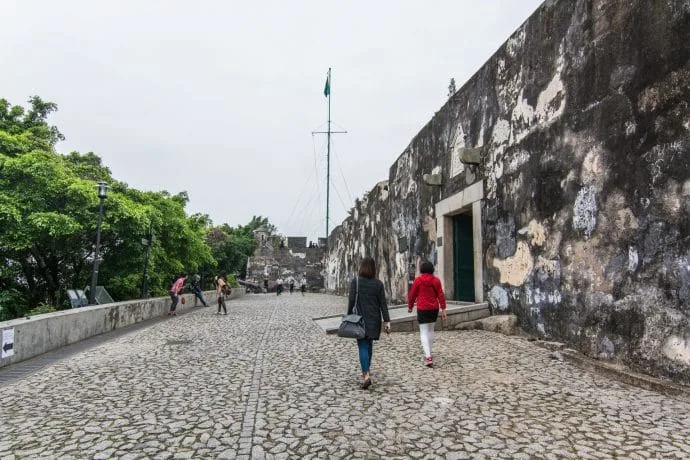
This fort, which was built in the early 17th century (1617-1626), was originally used to protect the Portuguese Jesuits' buildings from pirates. The fort then served as a residence for the governors of Macau for over 100 years, after proving crucial in stopping the Dutch invasions in 1622.
Remaining military and closed to the public, it was not until 1968 that it was converted to public use, initially with a weather station within it, before the construction of the Macao Museum, which opened in 1998.
Today, it is mainly for its view that we go there, at only 52m, it allows you to see the entire main island of Macau. However, it is not the highest point which is at the Guia fort, 700m as the crow flies from there.
We didn't have time to go there, but we could see its white lighthouse on the small hill that "culminates at 90m. This small fortress, built at the same time as Fort Monte where we were, also has a chapel that contains murals mixing Chinese and Western styles.
The atmosphere is good-natured, people climb on the cannons (not us) to take photos, it is clearly the haunt of lovers, street musicians, curious people like us.
In an old barracks, old photos of the fort were exhibited. Time to appreciate the view from all angles, admiring in particular the architecture of the Grand Lisboa hotel and casino, which, in addition to standing out from the urban landscape, is particularly noticeable with its very Chinese design.
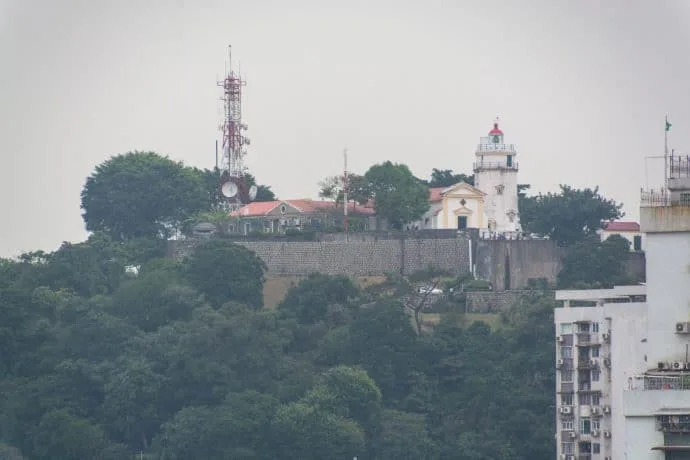
It was time for us to see the city's "star" attraction, the ruins of St. Paul's. St. Paul's is actually the ruins of a complex, consisting of the Church of the Mother of God of Macau and the foundations of St. Paul's College.
It is the facade of this Church of the Mother of God that has become the symbol of Macau and its greatest attraction. It is said to have served as a diocese at some time before the expulsion of the Portuguese Jesuits from Macau, which is why it is also known as St. Paul's Cathedral, after the name of the college next door.
Ravaged by a fire in 1835, it threatened to collapse and there was even consideration of demolishing it in the 90s. A wise decision to have kept it. The sculptures adorning the imposing façade date from the beginning of the 17th century. Established by Japanese Christian artists, they mix a unique oriental and European style.
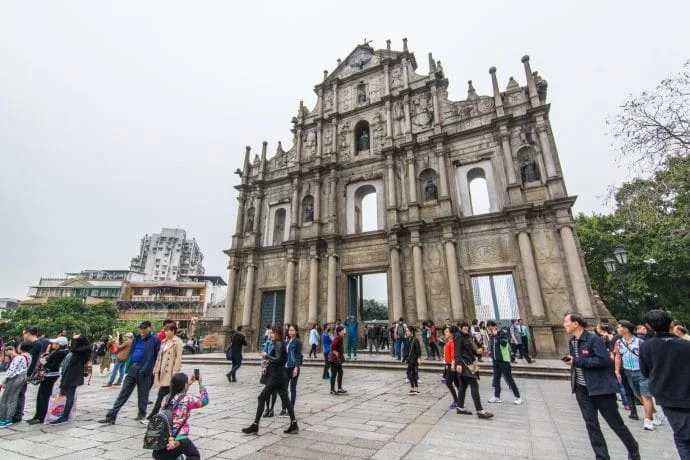

To find out a little more, Wikipedia page on the ruins will do it much better than me.
Too bad, because when it's quiet it's still a pretty spot, from the top of the stairs, there's a beautiful view of Macau, which contrasts with the older buildings that surround the square at the foot of the steps (mostly dating from the beginning of the 20th or end of the 19th century).
What I didn't know is that just behind the facade, on the left side, you can see, in addition to the small Chinese temple dedicated to Na Tcha (Na Tcha Temple) dating from 1888, one of the rare sections of the fortification wall still standing which surrounded the old city from the 16th century.
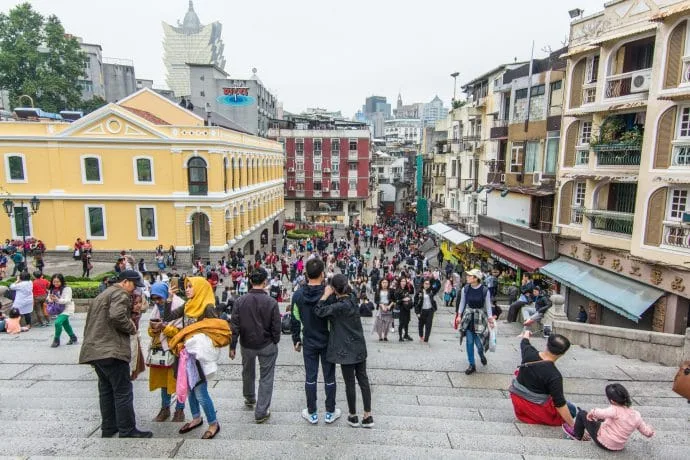
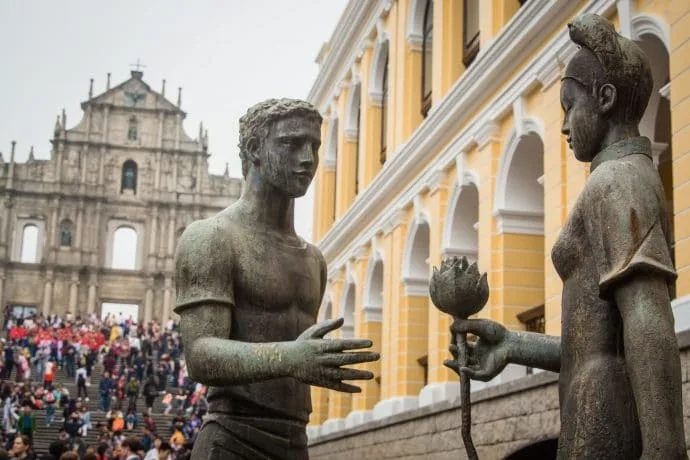
The grand staircase of 68 steps leading to the façade is crowded with people, of all ages, but 95% Asian, they take selfies everywhere and so we don't linger too long in the corner. After a photo of the sculpture below the façade, symbolizing the friendship between China and Portugal, we slipped away again into the small streets of Macau.
It was approaching tea time at our hotel and we wanted to enjoy the all-you-can-eat buffet served at that time as lunch. So we started to return to the Sofitel, not without going to see a Chinese temple on the way (Hong Kung Temple), which we could also see from our hotel.
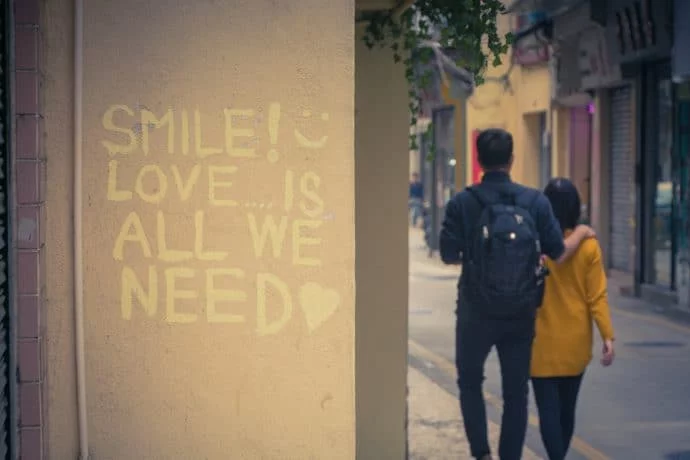
In the small streets of Macau
After this welcome break in "our neighborhoods", we went out again this time to explore a different area of the city, further south of the largo de senado. We came back near it before turning right to enter a small pedestrian street, the calle dos mercadores before joining the calle dos cules. Further on, we came across the pretty calle da felicidad, which goes down below on our right.
Lots of white facades with red shutters, reminding me a bit of the Basque country (quickly, eh…), the shape of these storefronts of commercial houses also made me think of horse boxes, who knows why…
We bought some local cakes in shops there before continuing along this street. Then we retraced our steps by going up the parallel street, the rue do gamboa. Knowing that we were doing all this relatively randomly, because we had nothing really planned about what we wanted to see.
In my mind, what was guiding me at that moment was to join another church, that of St Joseph, just to have a direction. We were passing in front of it, after having walked along small streets, sometimes lined with pastry shops, sometimes with garages so narrow that one wonders how they manage their business.
As this church was closed, we continued and came across another one, the church of St Lawrence, in a neoclassical style with a touch of Baroque. It is one of the 3rd oldest churches in Macau although the current version is more recent since it dates from 1848. We did not linger there too much.
We turned right there, because I wanted to reach the southern part of the island. So we went along Rua do Padre Antonio (I'm keeping the names in Portuguese on purpose, because a translation wouldn't help much if you're looking for the street on a map...).
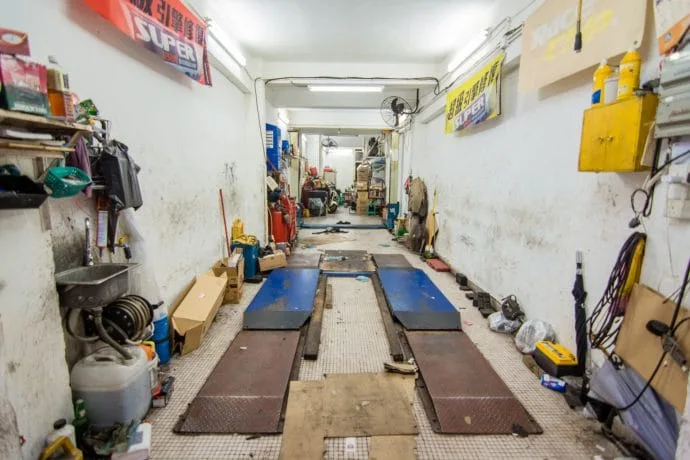
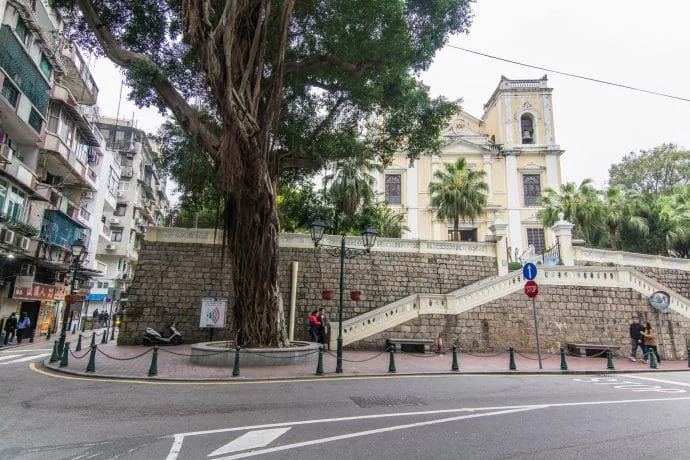
We passed further in front of the small square of Lilau while it was already starting to get late. Continuing on the same axis, then becoming the street da barra, we passed in front of the Moorish Barracks, if today it houses offices of the maritime administration of Macau, it was originally the "Moorish" barracks, which housed Indian soldiers posted from Goa to Macau.
The building itself has a unique style, since for once it is non-European but a mixture of Arab and Gothic architectural styles, despite being the work of a very European architect, since it was designed by the Italian Cassuto in 1871 (construction was completed in 1874).
Night was falling so we didn't linger too long and continued until we reached the Barra square. With on one side an administrative building of the maritime museum, and on the other, the temple of A-Ma, already closed...
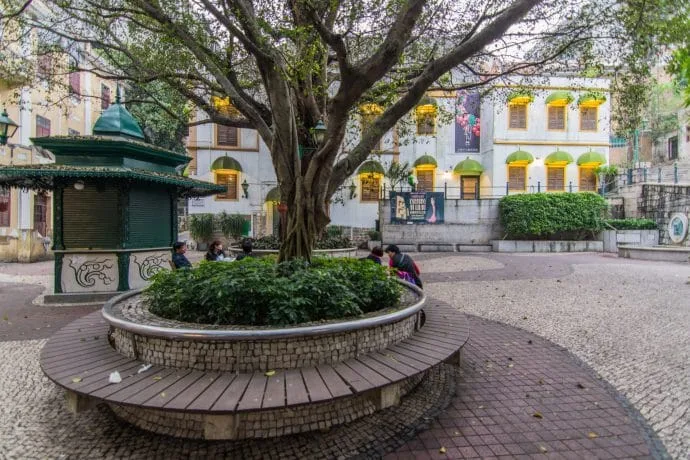
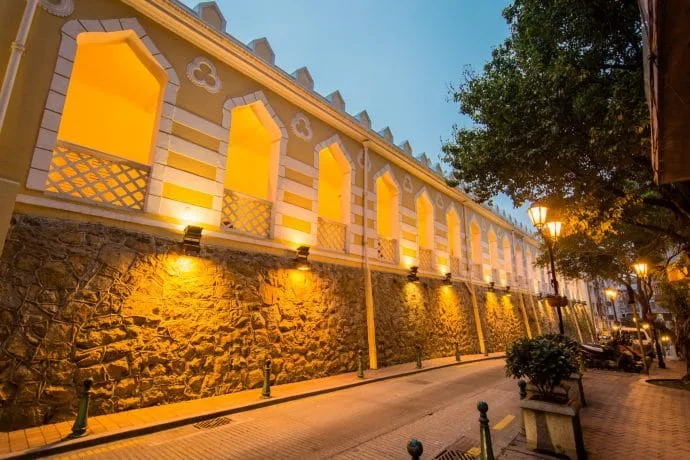
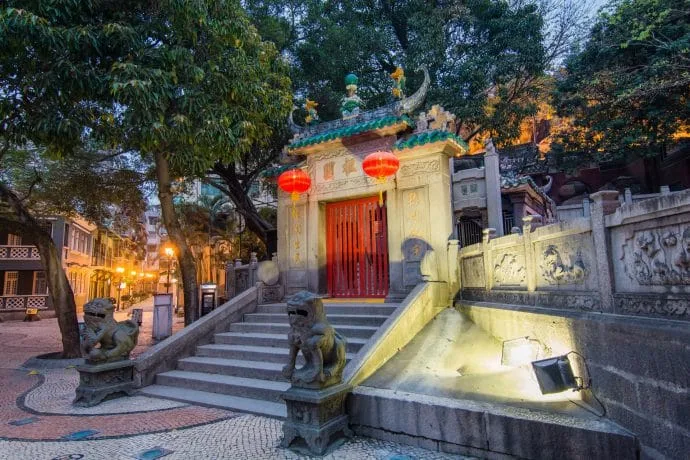
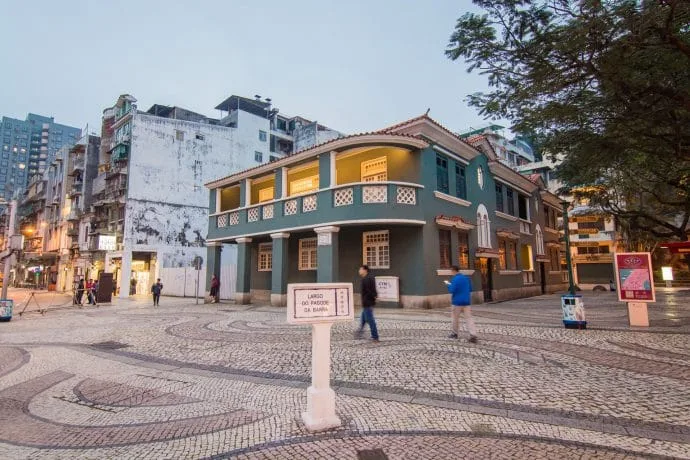
The idea was to go to the seafront to see the south island, but that would have been at least another 1,5km walk, it was dark, we would have walked along a main road, it wasn't worth it.
So we stopped our visits to the old town there. Since we couldn't leave Macau without going to see casinos, we left from there by bus to the island to the south. I will probably talk about it in a dedicated article and so I continue the story here concerning the old town only.
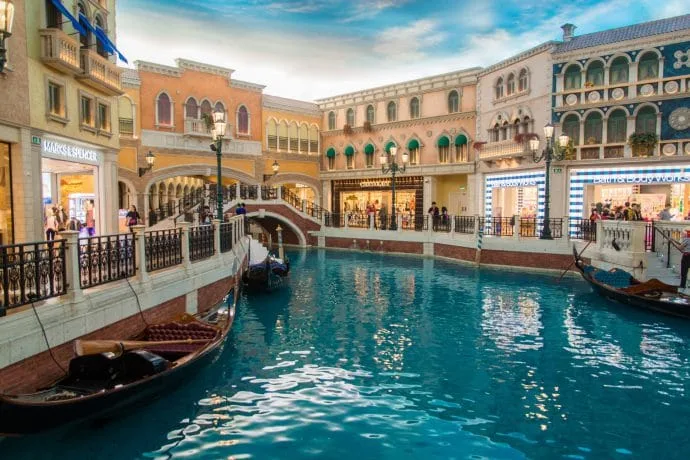
The temple of A-Ma and the chapel of Our Lady of Penha
After our night out at the casinos, we picked up the next morning where we had left off the day before, namely, in front of the A-Ma temple, whose buildings are scattered over an entire section of a small hill.
You should know that this temple has a particularity and not the least, that I did not know at the time of the visit! It is the oldest temple and oldest original building in Macau still present! This one would be the work of the original inhabitants of the peninsula, fishermen who would have built this place of worship in honor of the goddess Mazu, also called A-Ma (or Tin Hau ...), this, from 1488.
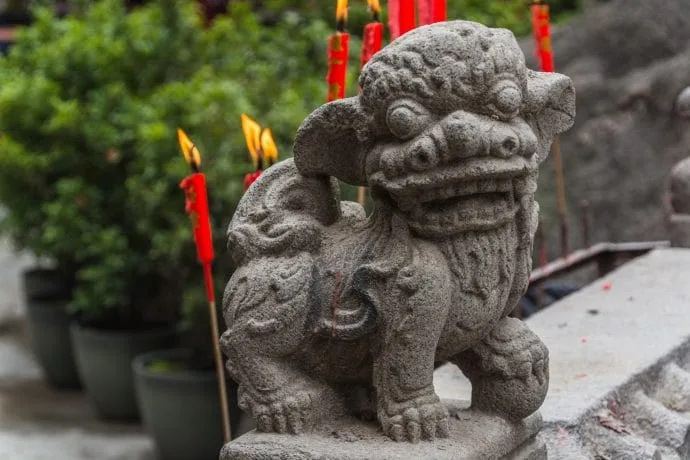
When the Portuguese landed in the middle of the 16th century, they asked what the name of this place was, and were told "A-Ma Gau", meaning in Cantonese, A-Ma Bay. Thinking that this was the name of the peninsula and by phonetic approximation, it was transcribed by the Portuguese as Amacao at first, before becoming "Macau"/"Macao" depending on the version later.
There are many inscriptions on rocks, buildings for praying, incense, lots of incense, shapes and colours that I am beginning to become familiar with from travelling in Asia.
All the buildings are from different periods, some from the beginning of the 17th century, a major renovation having also taken place at the beginning of the 19th century, the general appearance of the temple has remained unchanged since 1828.
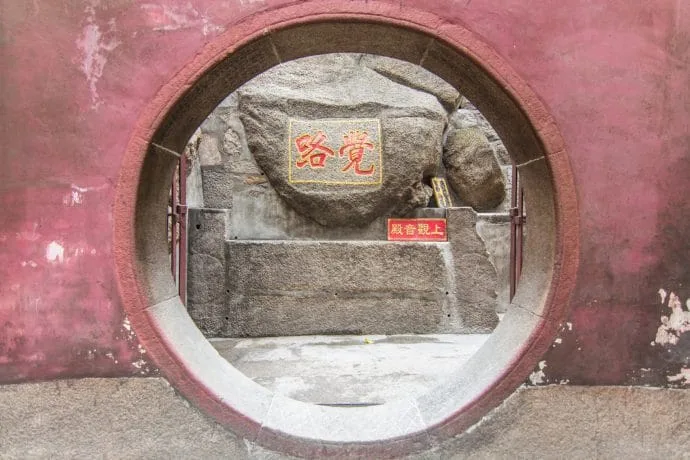
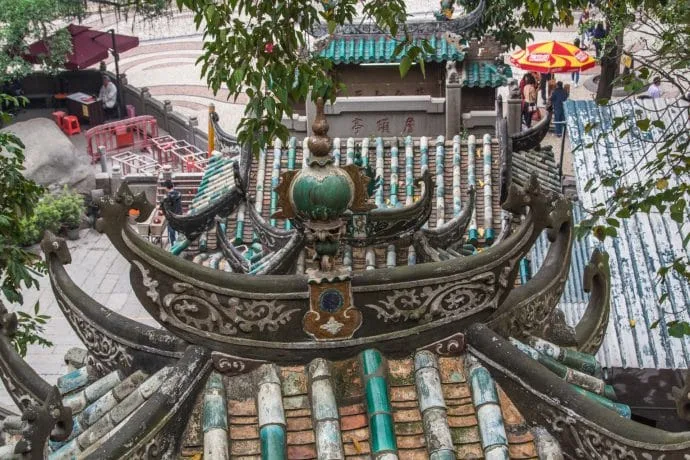
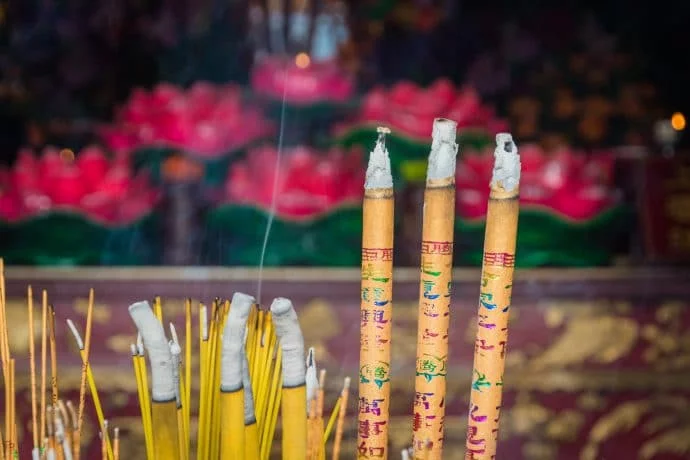

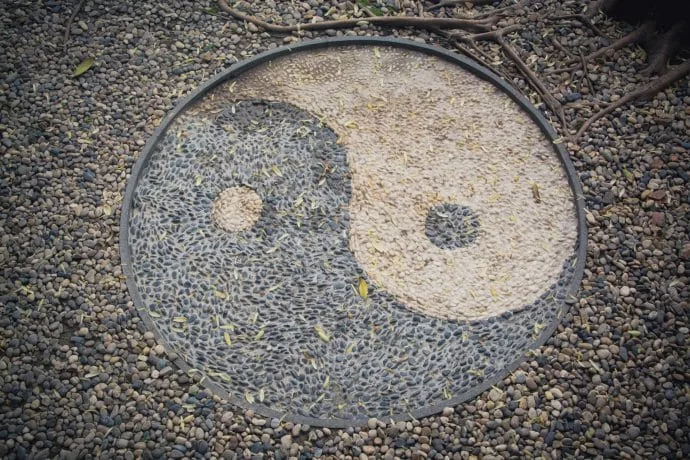
Before joining the South Island to complete our visit to Macau, I wanted to have a view already missed the day before on this famous island. I then decided to go up to see the chapel of Our Lady of Penha which would seem to allow that.
And from the temple, it was only 850m… Except that what I didn't see on Google Maps is that it's only 850m of climbing… So it took us 20 minutes to reach the chapel, passing through a clearly upscale neighborhood, given the guards in front of the porticos and large houses that we can see behind.
At least there was a view, although not as good as I had hoped. After taking a look inside the said chapel, we went back down. But rather than just turning back and walking the kilometer back to the main road, I thought we could cut back to go back down the north side of the hill by going to the small private street of Tv. da Penha thinking of joining the street da barra via the Tv. da Barra…
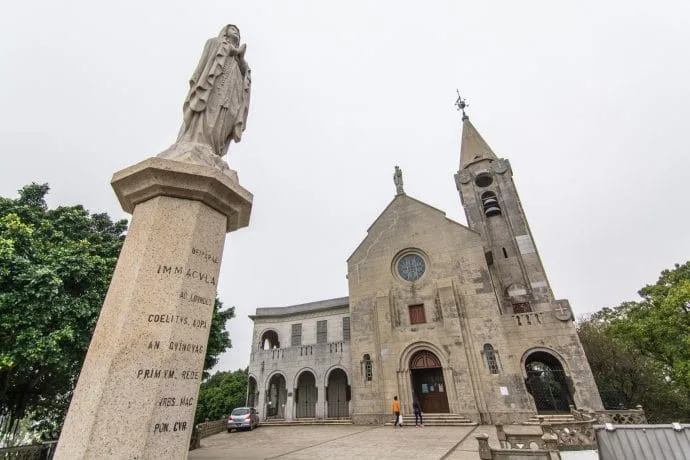
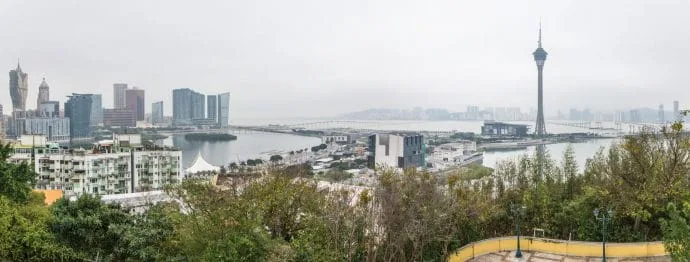
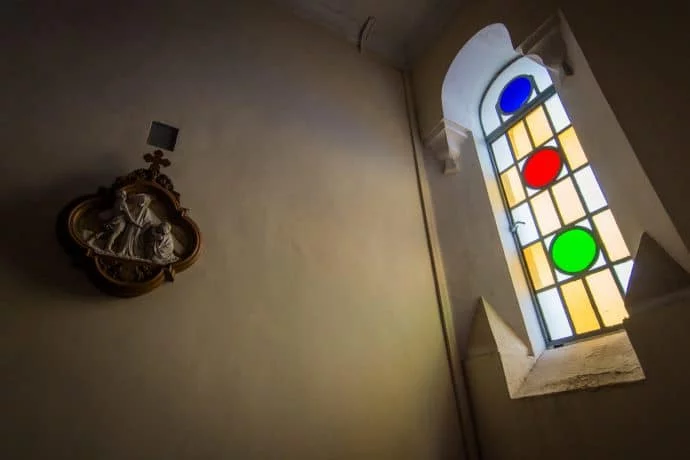
Doing this would "only" remove 200m less, but above all it would make you follow a different path, just to... Except that in fact, the street being private, it's a dead end... And the access to reach the Tv. da barra does exist, but it is also private...
We were about to turn around, resigned to retracing our steps when a kind local resident opened the gate (via an electronic card) separating this street from the stairs leading down to the Tv. da Barra, PHEW! And a big thank you to him!
We then went back down to the temple square to take a bus, direction Coloane! But that will be for a future article!
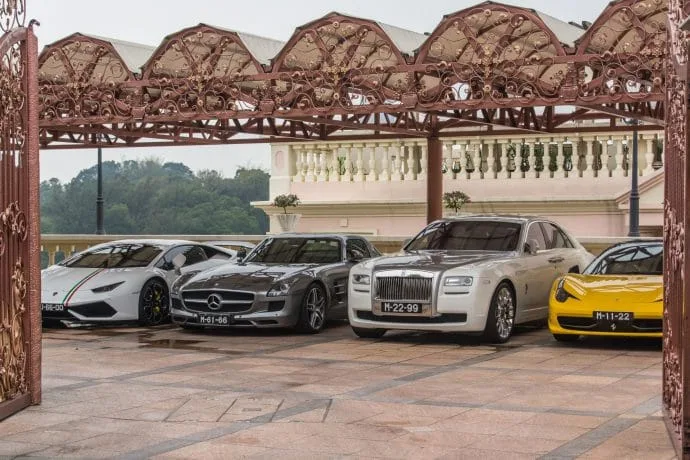
Review: My impressions of Macau
In the end, I am not unhappy with this little escapade on this small piece of Chinese land. As mentioned in the article, my first impression while walking around Macau is rather good. A city-state in perpetual evolution, Macau has managed to keep the heart of its history.
Despite the gloomy weather which made everything a bit sad in terms of colours, I appreciated this mix of cultures which gives a certain richness to the architecture, the food, at the crossroads between Asia and Europe.
Even though Asia predominates today, there are all these little touches that give the whole an interesting effect, like a strange feeling of being elsewhere, in this "distant and mysterious" Asia, but which, through these signs in Portuguese, these small streets lined with European buildings, these squares, the details in the decoration and all these churches, give us a feeling of familiarity.
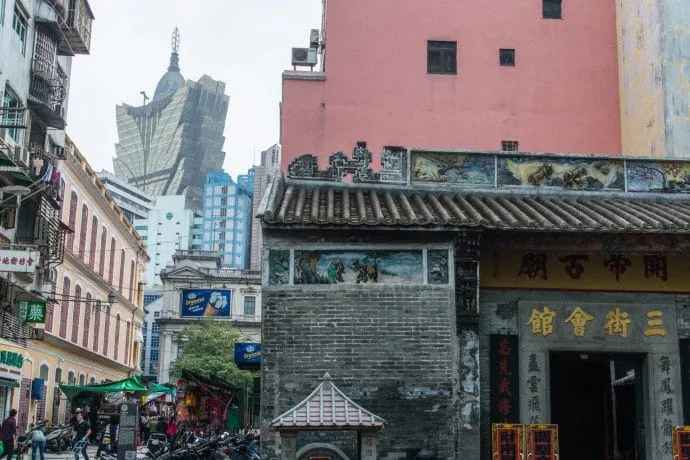
Without going so far as to give the impression of being at home, it gives an almost "reassuring" side, less disconcerting than some destinations in Asia (or elsewhere) can be, so different from our points of reference.
Macau represents a fusion of East and West, making it much more than just a "great Asian city." The region offers the most complete picture of the European architectural heritage that has remained intact in modern-day China. This formulation is from a Macau tourism document, which helped me write this article, but it sums up the historical attraction of the place well.
And to sum up Macau as simply the Las Vegas of the East would be reductive and deserves as much of a detour as the fantastic labyrinth that is Hong Kong, more widely preferred and visited in the region.
So, Macau, not even a little bit tempted?
Did you like the article? share on Pinterest!



